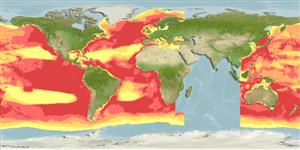Common names from other countries
Classification / Names / Names
Common names | Synonyms | Catalog of Fishes (gen., sp.) | ITIS | CoL | WoRMS
Environment: milieu / climate zone / depth range / distribution range
Ecology
Pelagic-oceanic; oceanodromous (Ref. 75906); depth range 0 - 8000 m (Ref. 1005). Tropical; 10°C - 28°C (Ref. 75906); 90°N - 90°S, 180°W - 180°E
Indo-Pacific, Atlantic Ocean and Mediterranean and Black Sea. Warm temperate and tropical waters. It is not reported in Antarctic territories (Ref. 128552) [Mediterranean population: IUCN 2010 (Ref. 84930): EN, A2abc.]
Length at first maturity / Size / Weight / Age
Maturity: Lm ?, range 160 - 190 cm Max length : 260 cm TL male/unsexed; (Ref. 1394); 230 cm TL (female); max. published weight: 135.0 kg (Ref. 1394)
Found in tropical coastal waters (Ref. 1522).
Life cycle and mating behavior
Maturity | Reproduction | Spawning | Eggs | Fecundity | Larvae
Seasonal reproduction (Ref. 97375).
Jefferson, T.A., S. Leatherwood and M.A. Webber. 1993. (Ref. 1394)
IUCN Red List Status (Ref. 130435: Version 2024-1)
CITES status (Ref. 108899)
Human uses
Fisheries: commercial
FAO - Fisheries: landings, species profile | FishSource | Sea Around Us
Tools
Internet sources
Estimates based on models
Preferred temperature
(Ref.
115969): 1.3 - 10.3, mean 2.4 (based on 15374 cells).
Resilience
Medium, minimum population doubling time 1.4 - 4.4 years (K=0.2; tm=9).
Vulnerability
Very high vulnerability (75 of 100).
Price category
Unknown.
